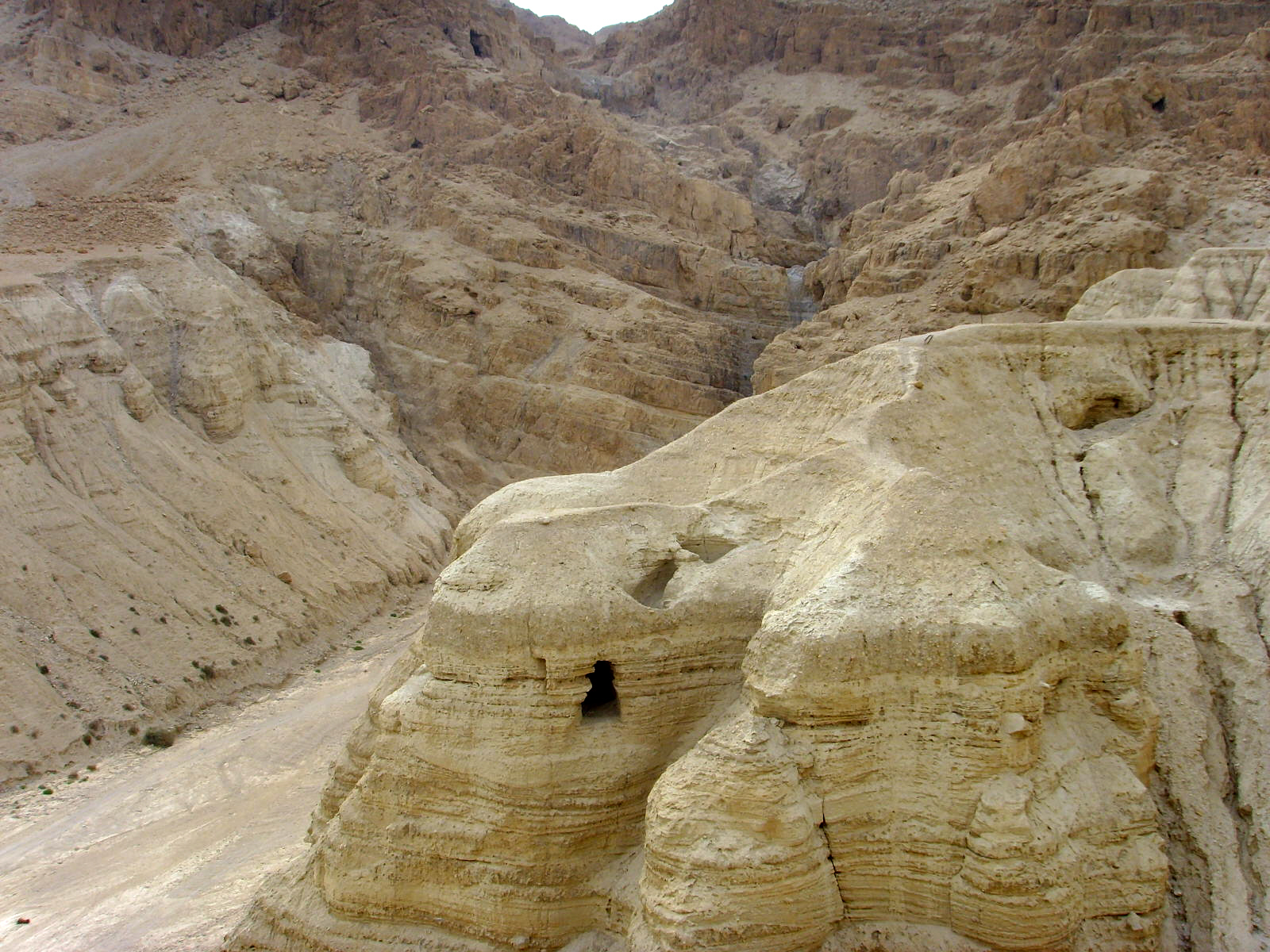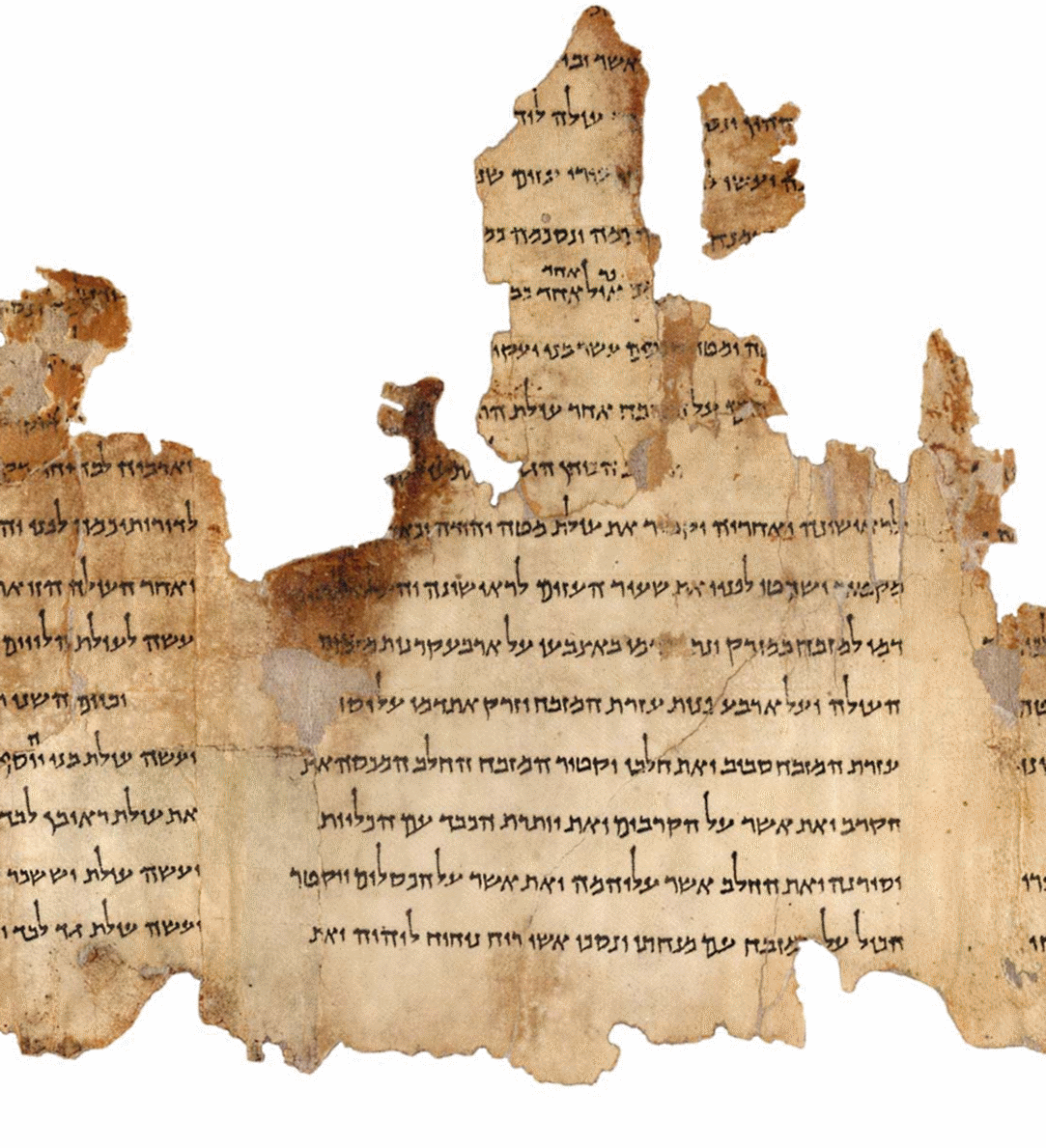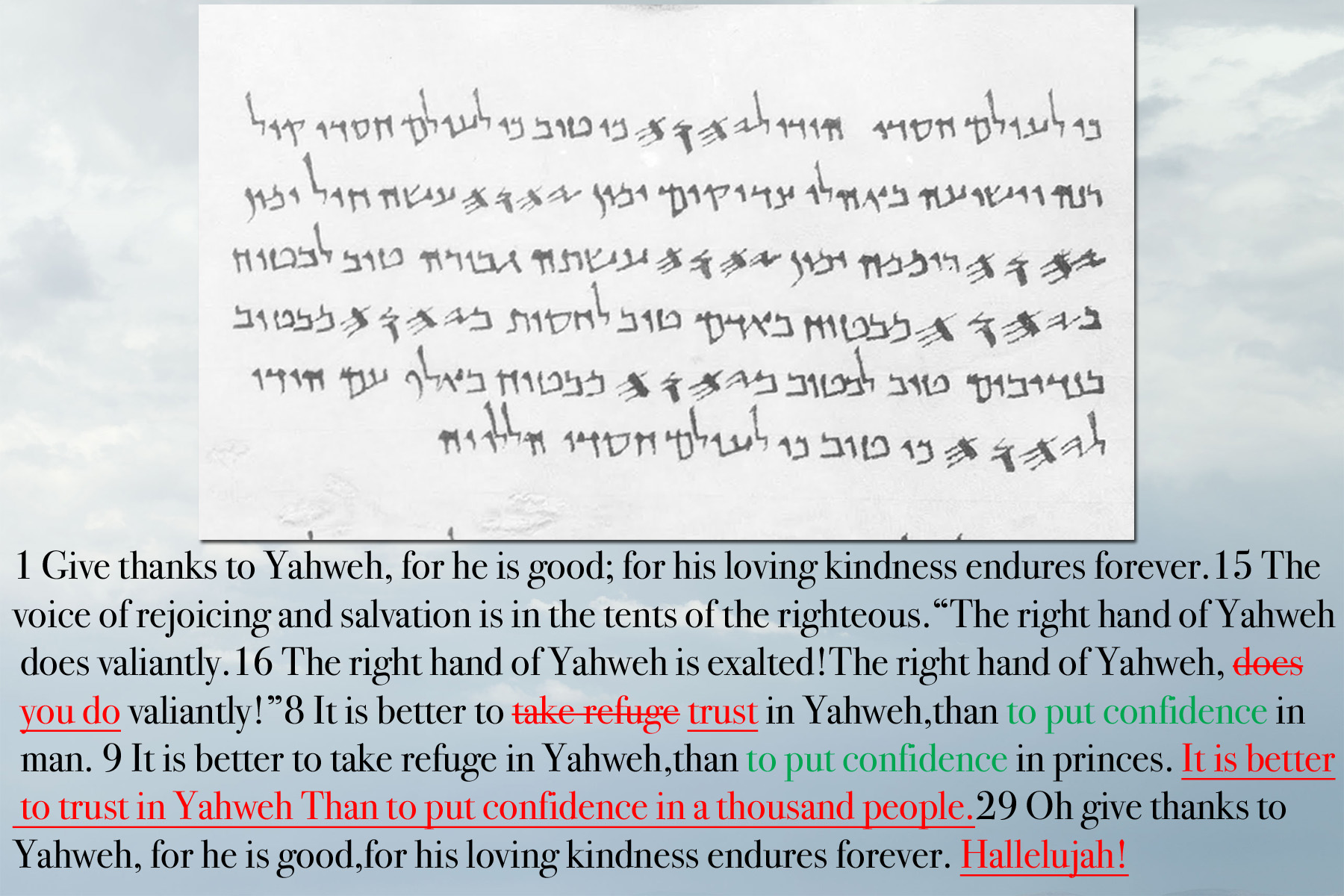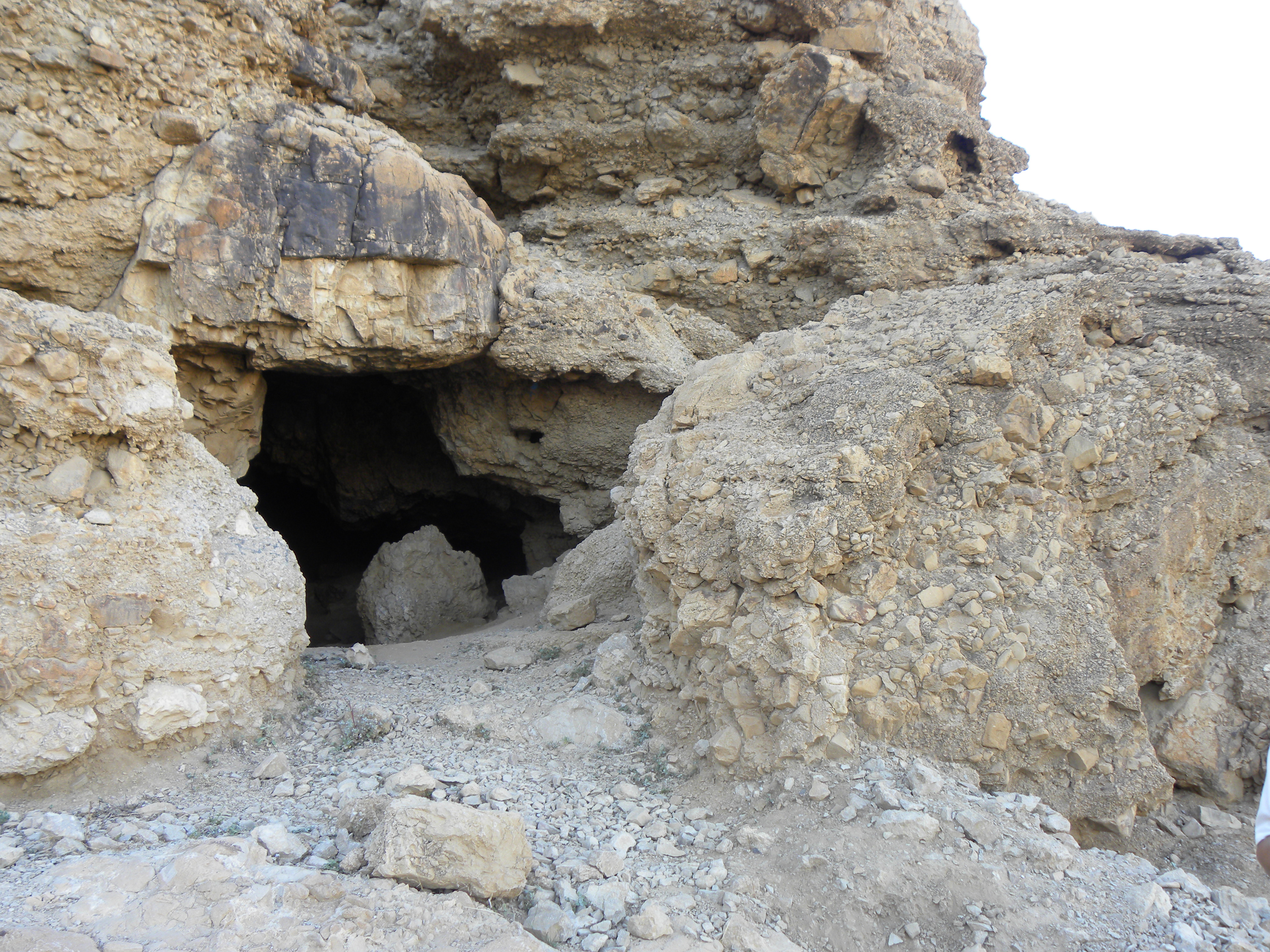|
The Qumran Caves
The Qumran Caves ( '; ''HaMeara Kumran'') are a series of caves, both natural and artificial, found around the archaeological site of Qumran in the Judaean Desert. It is in these caves that the Dead Sea Scrolls were discovered. Israel Nature and Parks Authority took over the site following the end of the 1967 war, when Israel occupied the West Bank and seized Qumran. Israel has since invested heavily in the area to establish the Qumran caves as a site of "uniquely Israeli Jewish heritage". The caves are recognized in Israel as a National Heritage Site, despite the caves being in occupied Palestinian territories; as such, the designation has drawn criticism. History The limestone cliffs above Qumran contain numerous caves that have been used over the millennia: the first traces of occupation are from the Chalcolithic period then onward to the Arab period. The artificial caves relate to the period of the settlement at Qumran and were cut into the marl bluffs of the terrace on whi ... [...More Info...] [...Related Items...] OR: [Wikipedia] [Google] [Baidu] |
Qumran
Qumran (; ; ') is an archaeological site in the West Bank managed by Israel's Qumran National Park. It is located on a dry marl plateau about from the northwestern shore of the Dead Sea, about south of the historic city of Jericho, and adjacent to the modern Israeli settlement and kibbutz of Kalya. The Hellenistic civilization, Hellenistic period settlement was constructed during the reign of Hasmonean dynasty, Hasmonean leader John Hyrcanus () or somewhat later. Qumran was inhabited by a Jewish religious movements#Sects in the Second Temple period, Jewish sect of the late Second Temple period, which most scholars identify with the Essenes; however, other Jewish groups were also suggested. It was occupied most of the time until and was destroyed by the Roman Empire, Romans during the First Jewish–Roman War, possibly as late as 73 CE. It was later used by Jewish rebels during the Bar Kokhba revolt. Today, the Qumran site is best known as the settlement nearest to the Qumran ... [...More Info...] [...Related Items...] OR: [Wikipedia] [Google] [Baidu] |
Gerald Lankester Harding
Gerald Lankester Harding CBE (8 December 1901 – 11 February 1979) was a British archaeologist who was the director of the Department of Antiquities of Jordan from 1936 to 1956. His tenure spanned the period in which the Dead Sea Scrolls were discovered and brought to public awareness. Without his efforts many of the scrolls might have disappeared into private collections never to be seen again. Life Harding was born in Tianjin, North China in 1901, but spent his childhood from age two to 13 in Singapore. He returned to the UK with his parents in 1913, but his father was killed in World War I, and Harding earned his living in a number of jobs from the ages of 16 to 25. During this time, he became fascinated by Egyptian hieroglyphics and eventually joined the evening classes run by the distinguished Egyptologist Dr Margaret Murray. Recognising his brilliance, she encouraged him to write to Sir Flinders Petrie and apply to go on one of his excavations. In 1926, Petrie was exca ... [...More Info...] [...Related Items...] OR: [Wikipedia] [Google] [Baidu] |
Carnelian
Carnelian (also spelled cornelian) is a brownish-red mineral commonly used as a semiprecious stone. Similar to carnelian is sard, which is generally harder and darker; the difference is not rigidly defined, and the two names are often used interchangeably. Both carnelian and sard are varieties of the silica mineral chalcedony colored by impurities of iron oxide. The color can vary greatly, ranging from pale orange to an intense almost-black coloration. Significant localities include Yanacodo (Peru); Ratnapura (Sri Lanka); and Thailand. It has been found in Indonesia, Brazil, India, Iran, Russia (Siberia), and Germany. In the United States, the official State Gem of Maryland is also a variety of carnelian called Patuxent River stone. History upright=1.1, Polish engraved_gem.html" ;"title="signet ring in light-orange carnelian engraved gem">intaglio showing Korwin coat of arms The red variety of chalcedony has been known to be used as beads since the Early Neolithic in ... [...More Info...] [...Related Items...] OR: [Wikipedia] [Google] [Baidu] |
Flint
Flint, occasionally flintstone, is a sedimentary cryptocrystalline form of the mineral quartz, categorized as the variety of chert that occurs in chalk or marly limestone. Historically, flint was widely used to make stone tools and start fires. Flint occurs chiefly as nodules and masses in sedimentary rocks, such as chalks and limestones.''The Flints from Portsdown Hill'' Inside the nodule, flint is usually dark grey or black, green, white, or brown in colour, and has a glassy or waxy appearance. A thin, oxidised layer on the outside of the nodules is usually different in colour, typically white and rough in texture. The nodules can often be found along s and [...More Info...] [...Related Items...] OR: [Wikipedia] [Google] [Baidu] |
Israel
Israel, officially the State of Israel, is a country in West Asia. It Borders of Israel, shares borders with Lebanon to the north, Syria to the north-east, Jordan to the east, Egypt to the south-west, and the Mediterranean Sea to the west. Israeli-occupied territories, It occupies the Occupied Palestinian territories, Palestinian territories of the West Bank in the east and the Gaza Strip in the south-west. Israel also has a small coastline on the Red Sea at its southernmost point, and part of the Dead Sea lies along its eastern border. Status of Jerusalem, Its proclaimed capital is Jerusalem, while Tel Aviv is the country's Gush Dan, largest urban area and Economy of Israel, economic center. Israel is located in a region known as the Land of Israel, synonymous with the Palestine (region), Palestine region, the Holy Land, and Canaan. In antiquity, it was home to the Canaanite civilisation followed by the History of ancient Israel and Judah, kingdoms of Israel and Judah. Situate ... [...More Info...] [...Related Items...] OR: [Wikipedia] [Google] [Baidu] |
Jerusalem
Jerusalem is a city in the Southern Levant, on a plateau in the Judaean Mountains between the Mediterranean Sea, Mediterranean and the Dead Sea. It is one of the List of oldest continuously inhabited cities, oldest cities in the world, and is considered Holy city, holy to the three major Abrahamic religions—Judaism, Christianity, and Islam. Both Israel and Palestine claim Jerusalem as their capital city; Israel maintains its primary governmental institutions there, while Palestine ultimately foresees it as its seat of power. Neither claim is widely Status of Jerusalem, recognized internationally. Throughout History of Jerusalem, its long history, Jerusalem has been destroyed at least twice, Siege of Jerusalem (other), besieged 23 times, captured and recaptured 44 times, and attacked 52 times. According to Eric H. Cline's tally in Jerusalem Besieged. The part of Jerusalem called the City of David (historic), City of David shows first signs of settlement in the 4th ... [...More Info...] [...Related Items...] OR: [Wikipedia] [Google] [Baidu] |
Hebrew University Of Jerusalem
The Hebrew University of Jerusalem (HUJI; ) is an Israeli public university, public research university based in Jerusalem. Co-founded by Albert Einstein and Chaim Weizmann in July 1918, the public university officially opened on 1 April 1925. It is the second-oldest Israeli university, having been founded 30 years before the Israeli Declaration of Independence, establishment of the State of Israel but six years after the older Technion university. The HUJI has three campuses in Jerusalem: one in Rehovot, one in Rishon LeZion and one in Eilat. Until 2023, the world's largest library for Jewish studies—the National Library of Israel—was located on its Edmond Safra, Edmond J. Safra campus in the Givat Ram neighbourhood of Jerusalem. The university has five affiliated teaching hospitals (including the Hadassah Medical Center), seven faculties, more than 100 research centers, and 315 academic departments. , one-third of all the doctoral candidates in Israel were studying at the ... [...More Info...] [...Related Items...] OR: [Wikipedia] [Google] [Baidu] |
Virginia
Virginia, officially the Commonwealth of Virginia, is a U.S. state, state in the Southeastern United States, Southeastern and Mid-Atlantic (United States), Mid-Atlantic regions of the United States between the East Coast of the United States, Atlantic Coast and the Appalachian Mountains. The state's List of capitals in the United States, capital is Richmond, Virginia, Richmond and its most populous city is Virginia Beach, Virginia, Virginia Beach. Its most populous subdivision is Fairfax County, Virginia, Fairfax County, part of Northern Virginia, where slightly over a third of Virginia's population of more than 8.8million live. Eastern Virginia is part of the Atlantic Plain, and the Middle Peninsula forms the mouth of the Chesapeake Bay. Central Virginia lies predominantly in the Piedmont (United States), Piedmont, the foothill region of the Blue Ridge Mountains, which cross the western and southwestern parts of the state. The fertile Shenandoah Valley fosters the state's mo ... [...More Info...] [...Related Items...] OR: [Wikipedia] [Google] [Baidu] |
Liberty University
Liberty University (LU), known simply as Liberty, is a Private university, private Evangelicalism in the United States, evangelical Christian university in Lynchburg, Virginia, United States. It is affiliated with the Southern Baptist Conservatives of Virginia (Southern Baptist Convention). Founded in 1971 by Jerry Falwell Sr. and Elmer L. Towns as Lynchburg Baptist College, Liberty is among the world's largest Christian universities and one of the largest private non-profit universities in the United States by total student enrollment. Liberty University consists of 17 colleges, including the Helms School of Government and the Rawlings School of Divinity. Most of its enrollment is in online courses; in 2020, the university enrolled about 15,000 in its residential program and 80,000 online. Its high number of students can be explained in particular by its tuition fees, which are among the lowest in the United States. Liberty's athletic teams compete in NCAA Division I, Division I ... [...More Info...] [...Related Items...] OR: [Wikipedia] [Google] [Baidu] |
Temple Scroll
The Temple Scroll () is the longest of the Dead Sea Scrolls. Among the discoveries at Qumran it is designated: 11QTemple Scrolla (11Q19 1QTa. It describes a Jewish temple, along with extensive detailed regulations about sacrifices and temple practices. The document is written in the form of a revelation from God to Moses, thereby with the intended meaning that this is the more appropriate temple which was revealed to Moses, and that Moses' instructions were either forgotten or ignored when Solomon built the First Temple in Jerusalem. In other words, in the mind of the Scroll writer, "Solomon should actually have built the First Temple as it is described here in the Temple Scroll". Introduction The Temple Scroll is written in Hebrew in the square Herodian script of the late Second Temple Period, and comprises 65 columns (19 pieces of leather) and is 9 metres in length.Johann Maier, ''The Temple Scroll'' (Sheffield: JSOT Press upplement 341985), p. 1. The outer part of the s ... [...More Info...] [...Related Items...] OR: [Wikipedia] [Google] [Baidu] |
The Great Psalms Scroll
The Great Psalms Scroll, also referred to as 11Q5, is the most substantial and well preserved manuscript of Psalms of the thirty-seven discovered among the Dead Sea Scrolls in the Qumran caves. It is one of six Psalms manuscripts discovered in Cave 11. Description The scroll was discovered in February of the year 1956, ten years after the initial discovery of the scrolls. It was purchased by The Palestine Archaeological Museum located in Jerusalem and first unrolled in November 1961. Four fragments of this scroll were later purchased by the same museum. The scroll's physical make up is that of dark yellow animal hide and is a little less than 1 mm thick. The primary body of the manuscript consists of "5 sheets of leather, still sewn together", and is 4.253 meters in length. It is estimated to have been copied anywhere from 30-50 AD, and is written in Biblical style Hebrew. When rolled out, it forms a slight arc, and the top part is clean and well kept, while the bottom is de ... [...More Info...] [...Related Items...] OR: [Wikipedia] [Google] [Baidu] |
Paleo-Hebrew Leviticus Scroll
Paleo-Hebrew Leviticus Scroll, known also as 11QpaleoLev, is an ancient text preserved in one of the Qumran group of caves, which provides a rare glimpse of the script used formerly by the Israelites in writing Torah scrolls during pre- exilic history. The fragmentary remains of the Torah scroll is written in the Paleo-Hebrew script and was found stashed away in cave no. 11 at Qumran, showing a portion of Leviticus. The scroll is thought to have been penned by the scribe between the late 2nd century BCE to early 1st century BCE, while others place its writing in the 1st century CE. The paleo-Hebrew Leviticus Scroll, although many centuries more recent than the well-known earlier ancient paleo-Hebrew epigraphic materials, such as the Royal Steward inscription from Siloam, Jerusalem (8th century BCE), now in the Museum of the Ancient Orient, Istanbul, and the Phoenician inscription on the sarcophagus of King Eshmun-Azar at Sidon, dating to the fifth-fourth century BCE, the Lach ... [...More Info...] [...Related Items...] OR: [Wikipedia] [Google] [Baidu] |









